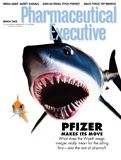Activate Your Audience
Marketers need to reach beyond disease awareness to spark "movement" communications campaigns
Unbranded disease awareness campaigns supported by pharmaceutical companies and non-profit health organizations have become part of the standard marketing communications mix; their goal is usually to inform the public about a disease or condition and drive patients and consumers to special Web sites, toll free numbers, and of course their healthcare providers. Certainly, a more informed patient is preferable to a naive one, but is an information push, no matter how well or creatively packaged, enough in today's crowded, skeptical market?

Chip Walker
Disease awareness should be replaced in the healthcare marketing playbook with a new approach. Marketers need to reach beyond awareness to activate the target audience—not merely broadcast to it. They need to create campaigns consumers and patients want to be a part of, rather than just ask their doctors about.
It's time for a "movement."
Tap Unknown Territory
What exactly is a movement? It's the mobilization of people to advance a goal or cause. A movement has authenticity, makes a powerful connection with its audience, and inspires action. A successful movement also has cultural relevance. For healthcare marketers, a movement motivates behavior by going beyond "health" and tapping into something deeper in consumers' lives. The time is ripe for a shift away from awareness campaigns.

Sandra Stahl
A September 2008 article in BrandWeek noted that Big Pharma's spending on unbranded drug ads has dropped dramatically over the past two years, from $660 million on health education and corporate image ads in 2006, to $341 million in 2007, to just $138 million in the first six months of 2008. In the article, Nielsen Monitor-Plus cited the lack of effectiveness of unbranded awareness efforts in a competitive environment for this significant decline in spending. While still standard, unbranded awareness efforts seem to be losing their appeal as the centerpiece of a communications campaign. Even when well conceived, the best these efforts can do is move the needle on awareness for all players. The value of these campaigns is limited, therefore, to the market leader.
Tough economic times call for a new approach. An examination of the Obama campaign, for example, provides some valuable lessons on how a movement strategy can coax the undecided into action. Movement strategy, vocabulary, and platforms can all be employed as tools to enhance patients' and consumers' feelings of authenticity about a campaign's messages and forge a closer bond with the brand, the disease, the cause, and the sponsor.
Memorable Movements
The first successful movement in our healthcare memory was for HIV/AIDS. The movement, which began in the early 1980s, was best symbolized by the red ribbon, a simple icon that demanded more from its audience than passive understanding of a deadly disease. Consumers were compelled to take action. For some, that meant a behavioral change; for others, a change in the level of attention; and for all, a change in attitude. The red ribbon created instant identification among participants. It signaled a sense of like-mindedness among people from all walks of life, and a feeling of that didn't previously exist for HIV/AIDS.
The ribbon was quickly taken up by breast cancer advocates. Among the many efforts to mobilize a range of audiences around this women's issue, Nancy Brinker, the woman behind the Susan G. Komen Foundation, was most successful at creating a movement with a unique identity. The Foundation's centerpiece, The Race for the Cure, gave women frustrated by the lack of attention to breast cancer research a productive outlet for their energy. The Race for the Cure remains successful at galvanizing women and partner corporations around a single cause.
Recognizing the marketing upside of such a campaign, Nike and Lance Armstrong teamed up in 2004 to create the LIVESTRONG initiative for cancer, symbolized by the yellow wristband. Like the red and pink ribbons, the yellow, rubberized, one-dollar LIVESTRONG bracelets became an easy, affordable way for people to demonstrate respect, support, and empathy for cancer survivorship. The results? People bought over 70 million wristbands. LIVESTRONG has been successful enough for Nike and Lance Armstrong to extend it with the introduction of a LIVESTRONG Collection of apparel, footwear, and accessories for men, women, and kids—a branded movement for the whole family.
In 2007, Pfizer dipped its toe in the movement waters after realizing that its investment in traditional disease awareness built around the Lipitor brand wasn't breaking through to the target audience of Americans over 40. The company's solution was to tap into the collective memory of the audience and unite them around this critical health cause. Pfizer's Boomer Coalition used a '60s-type manifesto and iconography to create a generational movement.
The campaign—comprised of a series of communications tactics including advertising, events, and guerilla, PR, and viral activities—aimed to motivate the boomer generation to sit up and take notice of a disease they didn't necessarily identify with. The result: 360 million impressions delivered at a fraction of the cost of a traditional media program, PR value estimated at over $20 million, 9 million Web hits in the first six months, 35,000 people mobilized and involved in campaign activities—all exceeding Pfizer's goals of creating relevance for cardiovascular disease and supporting the sales environment for Lipitor with more effective ROMI than previous traditional marketing efforts.
Spark Your Movement
How can pharma marketers spark a movement that will support their brands? Here are some strategies to consider:
- Determine the activists and drivers behind your movement The easiest way to do this is to identify a group that has both a strong business value to your brand (e.g., a need based on already diagnosed co-morbidities, dissatisfaction/failure with current therapy) and a discontent with one or more parts of the current discussion or activities within the disease state. For example, with the pink ribbon breast cancer movement, there was an emerging group of vocal, health-conscious women who felt powerless to help their mothers, sisters, aunts, and friends who were falling victim to breast cancer. The medical establishment didn't seem to be doing enough about it, and the group proved to be an important "activist" base for the seeding and growth of the area.
- Identify a "basis for participation" with your brand or program Determine what outcome you and your activist base want to achieve, what difference you can make in the world, and why people would want to participate in your effort to achieve that change. This basis for participation is the genesis for your movement.
- Mobilize your activist base Have a central message that's easy to pass on (e.g., "get tested now" or "expect more results from X medicine"). In some movements, it takes the form of a symbol (a bracelet or ribbon), an action (attend this event, log onto this Web site, join this opt-in program) or simple words ("change" for Obama.) Keep in mind that with a movement approach, your aim isn't just to expose your activist base to information and stories you can place in the media—they are your media.
- Have a mechanism in place to enhance the viral spread of your message Provide the tools that allow your audience to independently pass on the message to others: Web sites that provide online sharing tools, videos, and events they can invite others to attend. The end game is to build participation and message pass-along, not just awareness and knowledge.
Build Your Brand
Finally, there are several key questions pharma marketers should ask themselves when building movements:
WHO is my activist base?
WHAT is their dissatisfaction?
WHY would my program be able to help resolve this dissatisfaction? Why would they voluntarily participate?
WHAT message, symbol, or ritual will crystallize your movement's purpose?
HOW will my activist base replicate and spread the message/symbol?
NAME your movement
Pharma marketing stands at a crossroads between old and new paradigms. Starting a movement represents a strong advancement in connecting with the world of patients and consumers. A movement approach differs from traditional marketing in that it creates a program around a meaningful topic that consumers want to participate in and spread, activating a consumer base rather than broadcasting to it.
But perhaps the most important difference is that movements, unlike most marketing support, only work when they are based on a fundamental benefit for society. Thus, in a sense, a movement allows healthcare communications, like medicine, to become a helping profession, not only creating a point of difference for brands, but also creating purpose in the world.
We introduced equal rights and danced at Woodstock
We watched Neil Armstrong stroll across the Moon
We ushered in the sexual revolution
We gave birth to rock and roll
We even brought down the Berlin Wall
Will we be around to witness the next revolution?
— text from Pfizer's Boomer Coalition ad
Chip Walker heads the strategy practice at Strawberry Frog, a New York creative agency that specializes in sparking cultural movements. He can be reached at chip@strawberryfrog.com
Sandra Stahl is a partner in jacobstahl, an agency specializing in healthcare, well being, and consumer marketing communications. She can be reached at jacobstahl@aol.com

The Misinformation Maze: Navigating Public Health in the Digital Age
March 11th 2025Jennifer Butler, chief commercial officer of Pleio, discusses misinformation's threat to public health, where patients are turning for trustworthy health information, the industry's pivot to peer-to-patient strategies to educate patients, and more.
Navigating Distrust: Pharma in the Age of Social Media
February 18th 2025Ian Baer, Founder and CEO of Sooth, discusses how the growing distrust in social media will impact industry marketing strategies and the relationships between pharmaceutical companies and the patients they aim to serve. He also explains dark social, how to combat misinformation, closing the trust gap, and more.